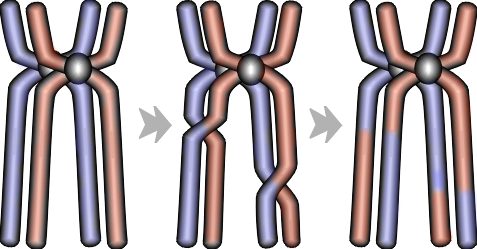
5/10/2002
The notation for the number of chromosomes has changed. Instead of "N", we are now using "C" . "N" would be appropriate when talking about ploidy, as in haploid, diploid and tetraploid, but "C" is more appropriate when talking about changes during a cell cycle.
TAKE HOME MESSAGE: [see close-up]
In MEIOSIS I, each daughter cell gets EITHER the maternal OR the paternal PAIR of chromosomes.
[NOTE: each chromosome is separate. There will almost always be a mix of chromosomes from the mother and father in the entire cell. That is, not ALL the maternal chromosomes will end up on one cell.]
In MITOSIS, each daughter cell gets ONE maternal chromosome and ONE paternal chromosome.
The following is to be used along with the MEIOSIS overhead. See also the two animations Meiosis I and Meiosis II
MITOSIS[#/cell]:
|
|
BIG RED |
BIG BLUE |
little red |
little blue |
C |
|
A |
2 |
2 |
2 |
2 |
4 |
|
B |
2 |
2 |
2 |
2 |
4 |
|
C |
1/1 |
1/1 |
1/1 |
1/1 |
2 |
MEIOSIS[#/cell]:
|
|
BIG RED |
BIG BLUE |
little red |
little blue |
C |
|
A |
2 |
2 |
2 |
2 |
4 |
|
B |
2 |
2 |
2 |
2 |
4 |
|
C |
2/0 |
0/2 |
0/2 |
2/0 |
2 |
|
D |
|
2 |
2 |
|
2 |
|
E |
|
2 |
2 |
|
2 |
|
F |
|
1/1 |
1/1 |
|
1 |
In the Meiosis II animation the "F" line above refers to the right hand pair of cells at the end of the animation.
|
A |
Starts at metaphase. The chromosomes have already duplicated, from 2C to 4C and the cell is ready to divide. There are two chromosomes BIG and little. There are two sets, one originally from the mother [red], one from the father[blue]. |
|
B |
This stage shows the difference between meiosis and mitosis. In Meiosis the duplicated chromosomes do not separate from each other [mitosis], but either a maternal OR a paternal set goes to each pole. |
|
C |
Cell division is complete. Both mitosis and meiosis are 2C at this stage. BUT, the genetic makeup of the two daughter cells in mitosis is identical, whereas in meiosis the genetic makeup is NOT identical [daughter cells are lacking either a maternal or paternal chromosome for each chromosome pair]. |
|
D |
Now the chromosomes line up as in mitosis, but there is only one pair of chromosomes for each chromosome, not 2C as in normal mitosis. |
|
E |
Chromosomes separate. |
|
F |
Daughter cells are now 1N [haploid], each with a mix of maternal and paternal chromosomes, but have a complete 1N set of all the chromosomes. [Normal cells have a 2N set, diploid] |
Meiosis explains how in sexual reproduction, traits that are on two different chromosomes in parents can come to be recombined in an offspring. [You have your father's nose and your mother's hair.]. Crossover explains how traits on the same chromosome, but coming from different parents can be recombined. There is a limit here as to how "flexible" a chromosome is and traits that are closer to each other or closer to the kineticore [black ball on figure below] on a chromosome are less likely to be exchanged. Crossover occurs at Stage Meiosis A as seen in the graphic overhead. This is when the maternal and paternal chromosomes are in close proximity to each other.

Taken together, meiosis and crossover, the possibilities of recombining of genetic information are immense. This gives sexual reproduction a significant advantage over asexual reproduction.
See the lesson MIXING THE GENE POOL. And information in MITOSIS & CENTROSOMES